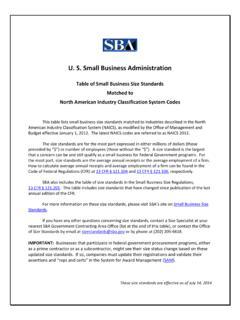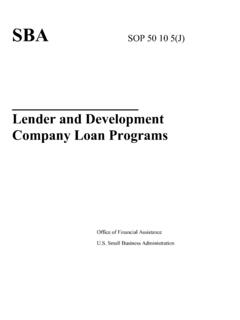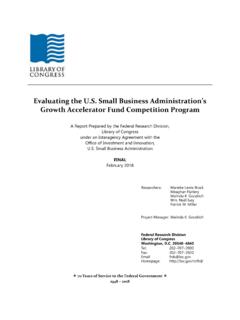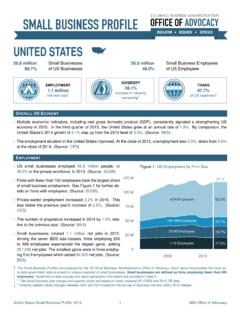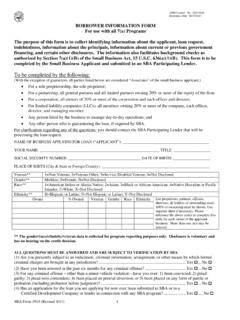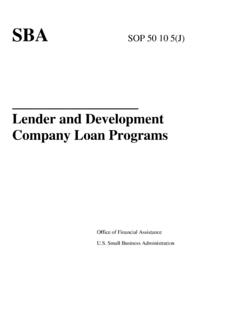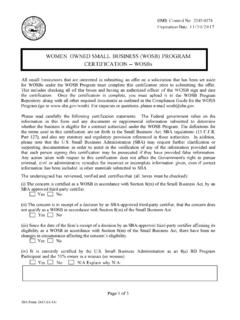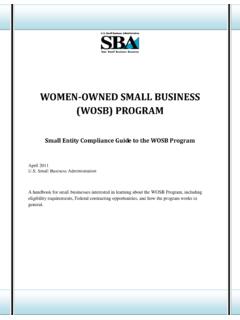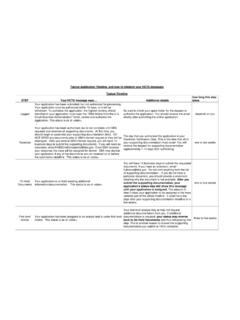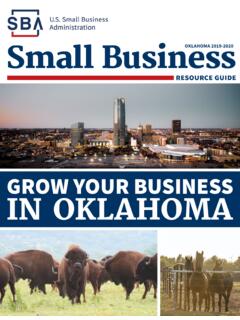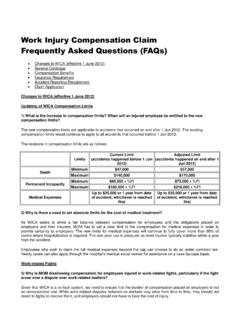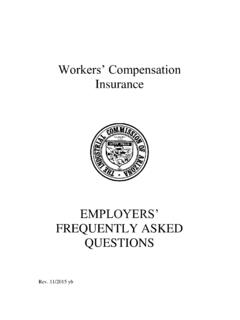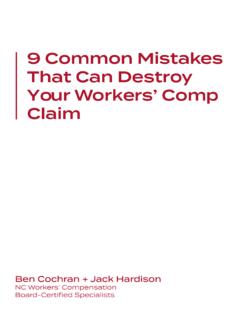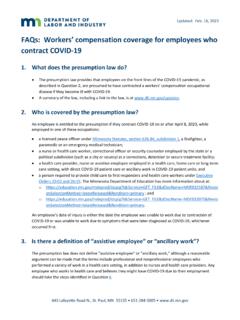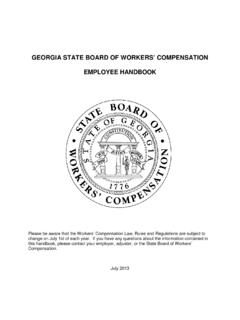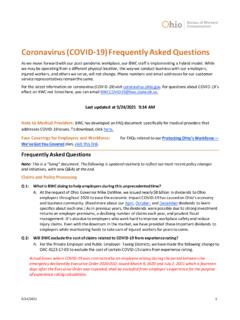Transcription of Borrower Frequently Asked Questions on Coronavirus ...
1 Borrower Frequently Asked Questions on Coronavirus disaster relief 1. Can sole proprietors claim their compensation on the EIDL and PPP loans? What if it is not paid out as salary but they are paid through a draw against net revenue of the business as their compensation ? What if a draw is not shown but it is net revenue on their personal tax return? Do they add the additional health care and other costs that are eligible to be covered? Yes, they can still apply. Lenders can verify income via tax documentation and bank statements. Payroll costs include: Salary, wages, commissions, or tips (capped at $100,000 on an annualized basis for each employee); Employee benefits including costs for vacation, parental, family, medical, or sick leave; allowance for separation or dismissal; payments required for the provisions of group health care benefits including insurance premiums; and payment of any retirement benefit; State and local taxes assessed on compensation ; and For a sole proprietor or independent contractor: wages, commissions, income, or net earnings from self-employment, capped at $100,000 on an annualized basis for each employee.
2 2. How can a 1099 contractor request a PPP loan? Is the average payroll cost the average monthly 1099 amount? Do they add the withholding tax they paid (FICA, FUTA, etc), healthcare and costs to get their average amount? For a sole proprietor or independent contractor: wages, commissions, income, or net earnings from self-employment, capped at $100,000 on an annualized basis for each employee. 3. How does an independent contractor use the recover lost 1099-Misc income? As written, the independent contractor has no payroll and often no business-related rent and utilities does that mean that there are no Allowable Uses? This seems to imply that the independent contractor can apply for a loan and calculate the max loan, but can t use it for anything. Further, if there are Allowable Uses, how does the independent contractor determine the amount of forgiveness? They can use the loan proceeds to cover their income for eight weeks.
3 Average monthly payroll will be estimated using tax documents and/or bank statements. 4. Can you clarify the timing of receipt of the $10,000 EIDL loan amount? Initial comments were 3 business days but some people have heard this was after a 10 day processing time period? The 3 day waiting time has passed for people who claimed last week and they have not heard back. We do not have a definitive answer on how long it will take to receive the funds. The disaster team originally stated 18-21 days for approval, but we have heard some individuals receiving an initial response in 11 days. 5. For the EIDL loan, will there be any clarity on the amount that will be approved based on operating expenses submitted. Will it cover 3 months, 6 months, 1 year, etc and how will the loan term be decided? A term sheet would be helpful to guide clients through the process. The loan officer will work with the business owner to determine the appropriate amount of recovery funds.
4 6. For the PPP loan, the application shows: Average Monthly Payroll: $ _____x + EIDL, Net of Advance (if Applicable) Equals Loan Request: $_____ Number of Employees: _____ Purpose of the loan (select more than one): Payroll Lease / Mortgage Interest Utilities Other (explain):_____ It looks like the loan request is based on average monthly payroll only. Where do the amounts for the other items noted lease/mortgage interest, utilities, other get calculated and for how many months of coverage? That calculation accounts for 8 weeks of payroll, plus an additional 25% of the loan amount for other costs. The majority of the loan (75% or more) should be used for payroll purposes. 7. How is the $10,000 grant amount calculated for the EIDL loan? Is it based on number of employees, % of loan amount or does everyone get the entire amount? To ensure that the greatest number of applicants can receive assistance during this challenging time, the amount of the Advance will be determined by the number of the pre- disaster ( , as of January 31, 2020) employees.
5 The Advance will provide $1,000 per employee up to a maximum of $10,000. 8. For the PPP application, there is a provision that states: Employers requiring furloughed workers to return to work by employers decertifying their unemployment status may be liable for damages for illness due to Covid-19. Is this meant to de-incentivize employers from recalling employees too early back to work. Should employers wait until any shelter in place executive orders issued by the state and local government had concluded before recalling employees so that they are not liable? We do not have the answer for this. What we do know is that if they apply for the PPP loan, they will have to hire their employees back once they receive the funds. 9. For faith based non-profits, please confirm that they are not eligible for the EIDL loan but are eligible for the PPP loans if they have staff on payroll? They are now eligible for both.
6 10. If a business used an agency for the first 9 months of 2019 & then brought them onto payroll, how do you calculate the average monthly payroll cost? Do you assume the employee was on payroll the entire year? The quarterly 940 will not reflect this information. Yes. 11. How do you calculate FTEs especially if a business uses seasonal or part time workers? Calculate total number of jobs, whether they were part time or full time employees. 12. In the text of the CARES Act, the term payroll costs is: (I) (aa) the sum of payments of any compensation with respect to employees .. and (II) shall not include taxes imposed or withheld [paraphrasing here]: FICA, Medicare, income taxes. Why is SBA and others saying that payroll costs are the gross amount of payroll? Under the Act, payroll costs are calculated on a gross basis without regard to ( , not including subtractions or additions based on) federal taxes imposed or withheld, such as the employee s and employer s share of Federal Insurance Contributions Act (FICA) and income taxes required to be withheld from employees.
7 As a result, payroll costs are not reduced by taxes imposed on an employee and required to be withheld by the employer, but payroll costs do not include the employer s share of payroll tax. For example, an employee who earned $4,000 per month in gross wages, from which $500 in federal taxes was withheld, would count as $4,000 in payroll costs. The employee would receive $3,500, and $500 would be paid to the federal government. However, the employer-side federal payroll taxes imposed on the $4,000 in wages are excluded from payroll costs under the statute. Basically, anything that is already covered in an employees paycheck is already being included, by including the gross pay. 13. With respect to seasonal employers and the amount forgiven, why are the wages paid and FTEs comparing the 8-25 week period after loan origination [in 2020] to Feb. 15-June 30, 2019. This would not be a comparable comparison?
8 SBA backdated the disaster assistance to February 15, 2020, and the loan period is covered until June 30, 2020. Therefore, they are using that time period to get the estimation of how many employees that business would employ during that time of year. For example, a seasonal business that hires the bulk of its employees during the winter months would not suffer the same economic impact a seasonal business that hires the bulk of their employees in the spring would. 14. Can I check on the status of my EIDL loan application? Unfortunately there is no way to check the status of the loan within the district office, or through disaster customer service. As you can imagine, SBA has received thousands and thousands of applications on this national disaster loan program. Please be patient and you will eventually receive email correspondence from the disaster team. According to applicants we have spoken to, it has taken approximately 11 days from the first submission to receive your initial response.
9 15. What if an eligible Borrower contracts with a third-party payer such as a payroll provider or a Professional Employer Organization (PEO) to process payroll and report payroll taxes? SBA recognizes that eligible borrowers that use PEOs or similar payroll providers are required under some state registration laws to report wage and other data on the Employer Identification Number (EIN) of the PEO or other payroll provider. In these cases, payroll documentation provided by the payroll provider that indicates the amount of wages and payroll taxes reported to the IRS by the payroll provider for the Borrower s employees will be considered acceptable PPP loan payroll documentation. Relevant information from a Schedule R (Form 941), Allocation Schedule for Aggregate Form 941 Filers, attached to the PEO s or other payroll provider s Form 941, Employer s Quarterly Federal Tax Return, should be used if it is available; otherwise, the eligible Borrower should obtain a statement from the payroll provider documenting the amount of wages and payroll taxes.
10 In addition, employees of the eligible Borrower will not be considered employees of the eligible Borrower s payroll provider or PEO. 16. My financial institution is no longer taking/isn t taking PPP applications. Is there another lender I can go to? Please reference our SC Lender List and the Paycheck Protection Find Lender Tool. Additionally, please know that most lenders are only servicing their own clients at this time. 17. Can I still receive the PPP loan to pay my employees if I have laid them off? You will have to rehire your employees once you receive the PPP funds, and keep them employed for at least an eight week period after receiving the loan. 18. I own my property, but the property is owned by my holding company, and my business pays rent to my holding company. Can I still use the PPP loan to pay rent? Yes, but do not double dip funds, and only apply under the business EIN, and not the holding company.
